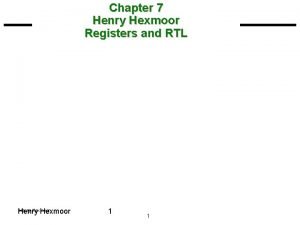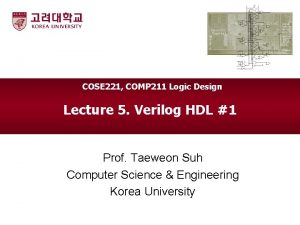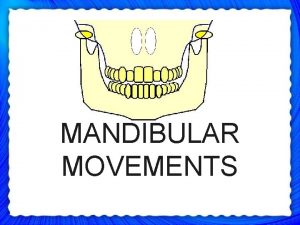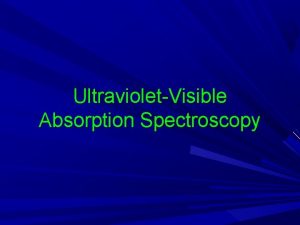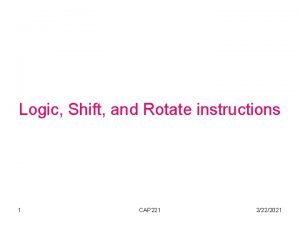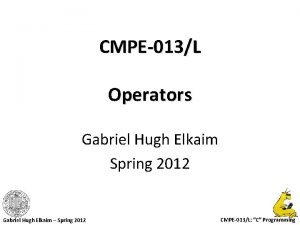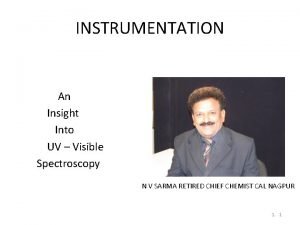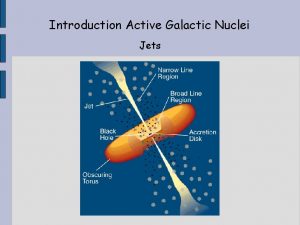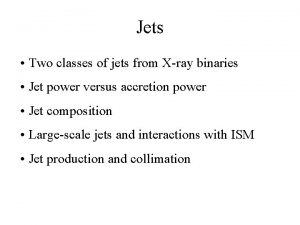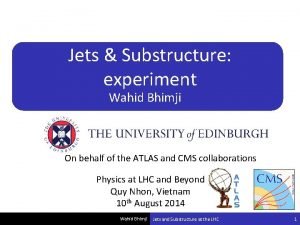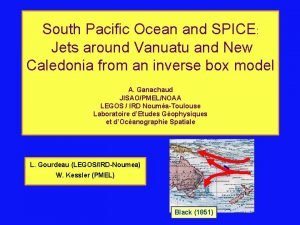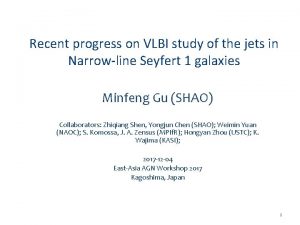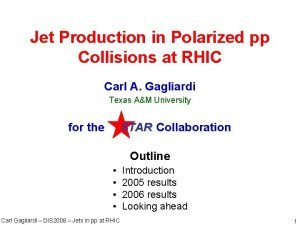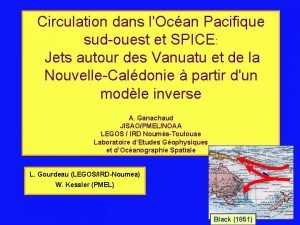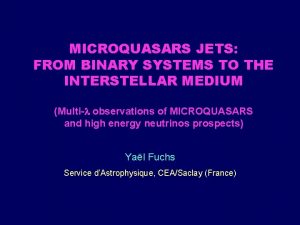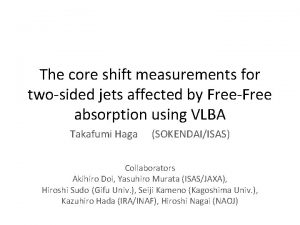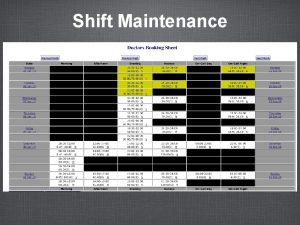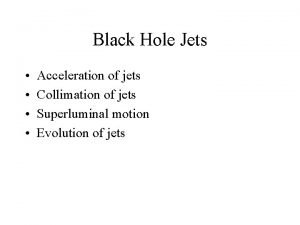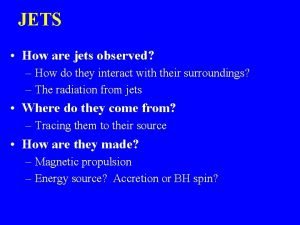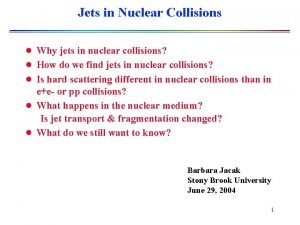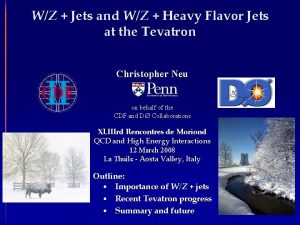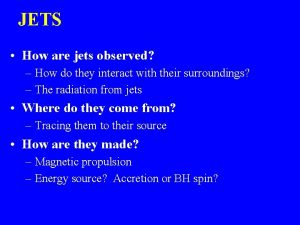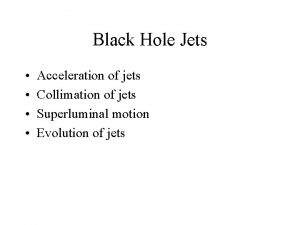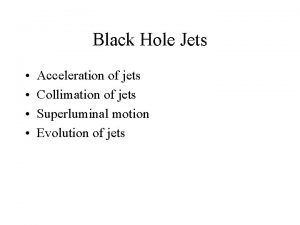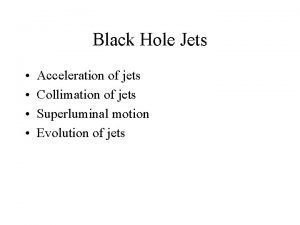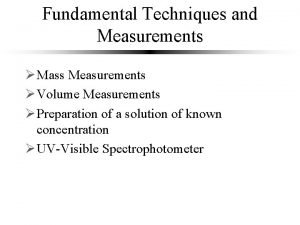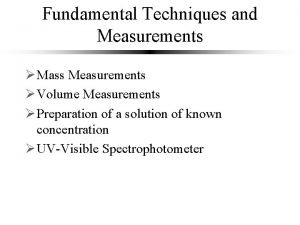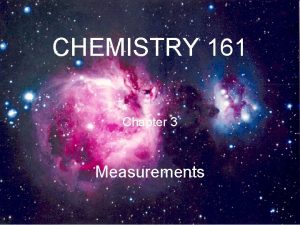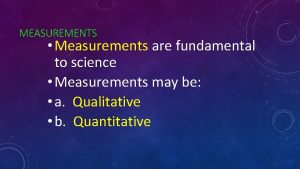The core shift measurements for twosided jets affected








![Observational summary Telescope VLBA (10 antennas) Observation mode Phase-referencing Frequency [GHz] 1. 4/2. 3/5. Observational summary Telescope VLBA (10 antennas) Observation mode Phase-referencing Frequency [GHz] 1. 4/2. 3/5.](https://slidetodoc.com/presentation_image_h/37a2c375cee0568fc4a444a5c3332371/image-9.jpg)
![Relative position form 43 G core [mas] Continuum maps and core shift measurements We Relative position form 43 G core [mas] Continuum maps and core shift measurements We](https://slidetodoc.com/presentation_image_h/37a2c375cee0568fc4a444a5c3332371/image-10.jpg)
![Relative position form 43 G core [mas] Core shift fitting on approaching jet Frequency Relative position form 43 G core [mas] Core shift fitting on approaching jet Frequency](https://slidetodoc.com/presentation_image_h/37a2c375cee0568fc4a444a5c3332371/image-11.jpg)









![Observation & Analysis Error budget (μas) Frequency [GHz] 1. 4 2. 3 5. 0 Observation & Analysis Error budget (μas) Frequency [GHz] 1. 4 2. 3 5. 0](https://slidetodoc.com/presentation_image_h/37a2c375cee0568fc4a444a5c3332371/image-21.jpg)
- Slides: 21

The core shift measurements for two-sided jets affected by Free-Free absorption using VLBA Takafumi Haga (SOKENDAI/ISAS) Collaborators Akihiro Doi, Yasuhiro Murata (ISAS/JAXA), Hiroshi Sudo (Gifu Univ. ), Seiji Kameno (Kagoshima Univ. ), Kazuhiro Hada (IRA/INAF), Hiroshi Nagai (NAOJ)

Outline • Introduction of Our project – Core shift measurements for two-sided jet • Where is the position of the black hole? – Our Targets • NGC 4261, 3 C 84, Cen A, Cyg A • Results of NGC 4261 – The black hole position – The interpretation of the counter jet core shift

Opacity effect • Radio core : Peak intensity at the upstream of a jet • Core position – The base of jet is absorbed ( It’s stronger at lower frequency. ) – Core positions seem to be different at each frequency ( = core shift ) – Core position ≠ position of the jet base Radio core at each frequency Jet in VLBI image ↑Black hole (and accretion disk )? Jet

The case of M 87 ( Hada+2011 Nature) u Accurate determination of the position of the jet base in M 87 • (14– 23) ± 4 Rs away from 43 GHz radio core. n The higher frequency is, the closer core is to the jet base ⇒ core ( @ν→∞ )→ jet base Jet base = BH position ? 4

Jet base = BH position ? • One-sided jet cases core (@ ν → ∞ ): lower limit of distance to BH BH of BL Lac case BH of M 87 case Core @ 43 GHz Visible Jet Standing shock model : 105 Rs Core shift model : 10 Rs (Hada+2011) ( Marscher+2006) • Two-sided jet cases – can limit range of BH position unambiguously

The goal of our research • Measurements of counter jet core shift • determine true position of BH BH Counter Jet Core shift BH

Our targets with two sided jet Centaurs A NGC 4261 Distance: 3. 6 Mpc 3 C 84 Distance: 30 Mpc Cygnus A Distance: 230 Mpc Distance: 70 Mpc

NGC 4261 • FR-I radio galaxy • 31. 6 Mpc (z=0. 0075) • − 1 mas ~ 0. 15 pc BH: 4. 9× 108 (Ferrarese + 1996) Gas &dust Disk (HST) Kpc scale jet (VLA) 30 kpc 100 pc (Tonry +2001) Msun • Viewing angle: θ = 63 ± 3° (Pinner +2001) pc scale Jet (VLBA @ 8 GHz ) Counter Jet (CJ) 8 GHz Approaching Jet (AJ) Gap • Intensity gap – The obscuration by disk • Edge-on, geometrically-thin, cold disk (104 K) Jones +2000. 2001 8
![Observational summary Telescope VLBA 10 antennas Observation mode Phasereferencing Frequency GHz 1 42 35 Observational summary Telescope VLBA (10 antennas) Observation mode Phase-referencing Frequency [GHz] 1. 4/2. 3/5.](https://slidetodoc.com/presentation_image_h/37a2c375cee0568fc4a444a5c3332371/image-9.jpg)
Observational summary Telescope VLBA (10 antennas) Observation mode Phase-referencing Frequency [GHz] 1. 4/2. 3/5. 0/8. 4/15/22/43 Date 28 th June, 2003 (15, 22, 43 GHz) 5 th July, 2003 ( 1, 2, 5, 8 GHz) Calibrator J 1222+0413 • 43 GHz resolution beam size 〜 0. 15 [mas] 〜 0. 04 pc 〜 1000 Rs J 1222+0413 Decl. 1. 7° R. A. NGC 4261 9
![Relative position form 43 G core mas Continuum maps and core shift measurements We Relative position form 43 G core [mas] Continuum maps and core shift measurements We](https://slidetodoc.com/presentation_image_h/37a2c375cee0568fc4a444a5c3332371/image-10.jpg)
Relative position form 43 G core [mas] Continuum maps and core shift measurements We can measure C-jet’s core shift for the first time Frequency [GHz] ●: jet core ●: C-jet core Relative position from 43 GHz core [ mas] 10
![Relative position form 43 G core mas Core shift fitting on approaching jet Frequency Relative position form 43 G core [mas] Core shift fitting on approaching jet Frequency](https://slidetodoc.com/presentation_image_h/37a2c375cee0568fc4a444a5c3332371/image-11.jpg)
Relative position form 43 G core [mas] Core shift fitting on approaching jet Frequency [GHz] Value error Ω -8. 42 ± 0. 86 k 1. 22 ± 0. 06 c 0. 082 ± 0. 016 Parameter c was determined to be 82 ± 16 μas (~310 ± 60 Rs) from 43 GHz core ・ Core_AJet@43 GHz < c < Core_CJet@43 GHz ・ c (core @ ν→∞) = BH position 11

Spectral index map (Sν∝να) 1 -2 GHz • Overlay maps at adjacent frequency – Considered core shift – Using same beam 5 -8 GHz • α > 2. 5 (inside heavy line) – 1 -2, 5 -8, 8 -15 GHz ν 1 ν 2

core shift is caused by SSA or/and FFA • Absorption at low frequency – Jet itself : synchrotron self-absorption (SSA) – Obscuration of accretion matter : free-free absorption (FFA) • αSSA ≦ 2. 5 The spectral difference between SSA and FFA

Pure SSA model • The difference of A-Jet / C-Jet – beaming factor • δ (β, θ) β: 0. 46, θ: 63° – ΩCJ < ΩAJ • Model – 5– 8 GHz : lager than pure SSA expectation – Others :as expectation from pure SSA core shift Counter Jet Approaching Jet SSA

SSA + FFA model • SSA jet + FFA disk – 5, 8 GHz: affected by FFA disk – Other : consistent with pure SSA • Limited regions within 0. 4 pc FFA Disk τFFA:FFA opacity, ne: electron density, T : temperature L : path length in absorbers • ν ≦ 2 GHz : outside disk (low density) • ν ≧ 15 GHz : too high temperature : frequency dependence observers Jet

Summary • We measured core shift of NGC 4261 not only on main jet side but also counter jet. – The jet base practically represent the BH position. – The BH position of NGC 4261 is determined unambiguously. • It is located within 82 ± 16 μas (310± 60 Rs) from 43 GHz core • C-Jet core shift can’t be interpreted as pure SSA core shift. – Contribution of FFA disk

Going on analysis 3 C 84 phase referencing observation Decl. Target 8. 4 GHz 12 GHz 15 GHz 22 GHz 1. 28° Calibrator R. A. P. A. – 55° 1. 6 GHz 2. 3 GHz 5. 0 GHz 8. 4 GHz Calibrator: J 0313+4120

Thank you for your attention!

Observational summary Telescope VLBA (10 antennas) Observation mode Phase-referencing Date 24 th January, 2013 Freq. [GHz] OST [min] Pol. BW [MHz] • 3 C 84 (NGC 1275) – Distance: 70 Mpc • 1 mas〜 0. 35 pc 1. 6 15 LL/RR 256 2. 3 15 RR* 256 5. 0 30 LL/RR 256 • New Mark 5 C system 8. 4 15 RR* 256 – Data rate : 2 Gbps 12 40 LL/RR 256 15 40 LL/RR 256 22 70 LL/RR 256 43 120 LL/RR 256 8 GHZ

Spectral index maps 8 -12 GHz 12 -15 GHz
![Observation Analysis Error budget μas Frequency GHz 1 4 2 3 5 0 Observation & Analysis Error budget (μas) Frequency [GHz] 1. 4 2. 3 5. 0](https://slidetodoc.com/presentation_image_h/37a2c375cee0568fc4a444a5c3332371/image-21.jpg)
Observation & Analysis Error budget (μas) Frequency [GHz] 1. 4 2. 3 5. 0 8. 4 15. 4 22. 2 43. 2 Beam size/ SNR 52 24 10 6 4 3 2 Ionosphere 2006 779 161 57 17 8 2 Troposphere 13 13 Core identification 349 60 17 40 0. 2 5 3 Earth orientation 5 5 5 5 Antenna position 2 2 2 2 Apriori Source coordinates 1 1 1 1 Total error (RSS) 2055 792 170 77 30 23 19 21
 Difference between arithmetic shift and logical shift
Difference between arithmetic shift and logical shift Red shift and blue shift
Red shift and blue shift Difference between arithmetic shift and logical shift
Difference between arithmetic shift and logical shift Posselt's diagram
Posselt's diagram Aniline uv spectrum
Aniline uv spectrum Verilog
Verilog Cap 221
Cap 221 Gabriel hugh elkaim
Gabriel hugh elkaim Bathochromic shift and hypsochromic shift
Bathochromic shift and hypsochromic shift Beaming
Beaming Jets
Jets Jets
Jets Spice jets
Spice jets Black hole jets
Black hole jets Jets
Jets Spice jets
Spice jets Microquasars
Microquasars Core shift analysis
Core shift analysis Core rigidities
Core rigidities Inner core and outer core
Inner core and outer core The strong lower part of the mantle
The strong lower part of the mantle Which layer is the least dense
Which layer is the least dense
